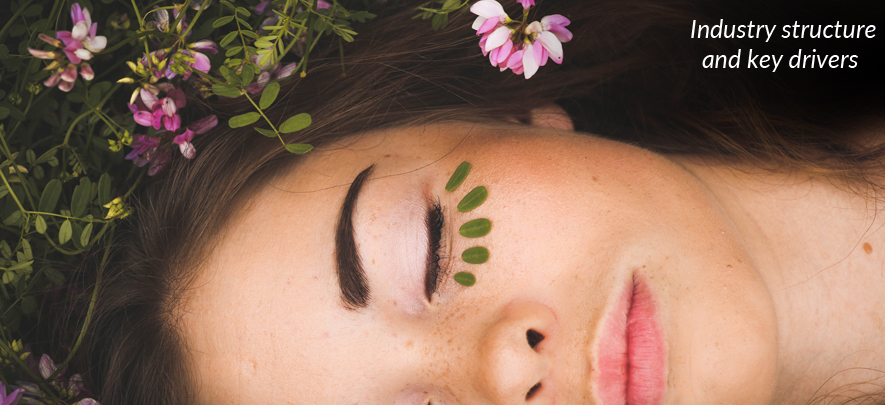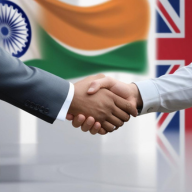Beauty and wellness industry: Industry structure and key drivers

Health & Lifestyle
304 week ago — 9 min read
Digital disruption is quickly taking over the beauty and the wellness industry. Technology-led startups that are offering innovative products and services to woo their customers are winning at it and traditional players are catching up with new trends such as Artificial Intelligence (AI), Machine Learning, Augmented reality (AR) and data analytics.
In our previous article, we shared the key segments and growth opportunities in the beauty and wellness industry. In this article you will learn about the industry structure and its key drivers.
Excerpts from the report titled Wellness and beauty- An ecosystem in the making by Federation of Indian Chambers of Commerce and Industry (FICCI) in collaboration with Ernst & Young (EY).
Industry structure
The Indian wellness and beauty industry is largely unorganised and fragmented. However, it is swiftly moving towards consolidation and formalisation with the entry of large organised players.
Let us take a look at the structure governing wellness industry:
Nutraceuticals
The nutraceuticals market is inhibited by both domestic and international players alike. Pharmaceuticals and FMCG companies control the majority of the nutraceutical segment, with select few companies that specialize only in nutraceutical products. The health supplements market is led by Amway India with a 33.8% market share, followed by Pfizer. In the fortified or functional packaged food segment, Cargill India enjoys a leading retail value share of 20%, whereas GlaxoSmithKline dominates the fortified/functional beverages market with a retail value share of 64%.
Fitness and slimming
The organised fitness industry stands at ~28% of the total industry size and is expected to grow at a CAGR of ~25% for the next three to five years. However, Talwalkars Better Value Fitness leads the organised segment with a market share of ~41% by the number of outlets, followed by Gold’s Gym having a 24% share. An exponential growth of the digital economy has given birth to a host of start-ups that leverage technology to provide specialised products and services and enhance consumers’ experiences.
Alternate therapies
Alternate therapies is a predominantly an unorganised industry with micro, small and medium enterprises powering more than 80% of the segment. The product offerings under AYUSH sector is made by FMCG giants like Dabur, Patanjali, etc. Whereas, there are a few organised players like Dr. Batra’s and VLCC in the service delivery space.
The beauty service industry is also largely unorganised with a number of small, local and regional players operating salon, spas and clinics. As the industry is growing, more organised players (both domestic and international) are likely to enter the market. The share of organised players is expected to rise from current 25% to 30% in the near future.
Also read: The 5-minute reflection guide for business owners
Operating model
In the organised salon and spa market, most players follow the franchising model, which is growing at a rate of 30%-35% annually. Additionally, players are reducing the company owned operations (COCO) due to huge investments in terms of time and money.
As the beauty industry is growing, more organised players (both domestic and international) are likely to enter the market. The share of organised players is expected to rise from current 25% to 30% in the near future.
Key drivers for the wellness and the beauty industry
Let’s look at the factors that are driving this change in the beauty and wellness vertical:
Increase in lifestyle-related ailments
According to the World Health Organisation, India has the highest number of diabetics at 50.8m, which is expected to increase to 73.5m by 2025. India also inhabits 25m people suffering from cardiovascular diseases. Exponential increase in the occurrence of these chronic diseases has brought preventive healthcare into mainstream.
Rising cost of curative healthcare
According to National Sample Survey Office (NSSO) health survey 2013—2014, the annual health expenditure of more than 14% of the households, exceeded their annual per capita consumption expenditure. The mounting financial burden of healthcare is also substantiated by the share of out-of-pocket (OOP) health expenses, which refers to the direct payments made by households to healthcare providers at the time of service use. Inadequate health insurance coverage and increasing cost of medical care has led to a shift in Indian mind-set towards preventive healthcare.
Government support
Introduction of Make in India, Insolvency and Bankruptcy Code (IBC) and Goods and Services Tax (GST), have been pivotal in improving India’s ranking in World Bank’s ease of doing business index by 30 ranks. It succeeded in lobbying the UN to declare 21 June as “International Yoga Day”. The government has also initiated certain targeted measures like tourism promotion, tax exemption on yoga and setting up wellness centres under “Ayushman Bharat” program. These centers will provide comprehensive health care, including free essential drugs and diagnostic services.
Government’s mHealth initiatives such as mCessation and mDiabetes aim to encourage people to quit tobacco and manage diabetes, respectively.
Also read: Let food be your medicine: Diet for disease prevention
Buoyant investment landscape
In July 2018, US-based venture capital firm RoundGlass Partners doubled its investment in Gympik.com, an online marketplace for discovering fitness centers and gyms. Additionally, peripheral industries like apparel, personal care and consumer services are also pouring in money to ride the growth wave. In April 2018, FMCG major Marico announced an acquisition of 22.5% share of Revofit, a fitness and holistic wellness platform. The optimistic investor sentiment is laying down a conducive environment for the growth of the industry.
Increasing grooming awareness among men
The rise of metro sexuality concept and the number of male customers has been steadily rising and are expected to grow stronger in the coming years. Companies are therefore investing to capture this huge untapped market.
Rising middle class population
The middle-class population accounts for 19% of the total population in India and is expected to reach 70% by 2048. As middle class grows and more people move up the hierarchy, the demand for beauty products and services would rise strongly. Leading players are already targeting this opportunity by introducing or acquiring new formats such as on-demand at-home services which have become affordable and convenient, making it accessible to the middle class.
Rising disposable income
According to the International Monetary Fund, the GDP in India grew at around 7.3% in FY18 and is expected to grow at the same rate in FY19. Simultaneously, as per the Ministry of Statistics and Programme Implementation (MoSPI) the per capita income in India has grown at a CAGR of 10.8% over FY14—FY18 to reach US$1,5735. The increased purchasing power will also empower customers to spend more on wellness and beauty services.
Urbanisation
According to the World Bank estimates, around 33.5% of the population in India lives in urban areas. Urban population forms a major consumption base for the beauty industry and companies have a strong focus to capitalize it.
Huge young population base
In 2018, more than 50% (around 600m) of the total population in India is under 25 years of age and more than 65% of the population is under 35 years of age. There is a growing trend among youth to stay fit and look presentable, which is expected to drive growth for the industry.
As you can see, a number of crucial factors govern the wellness and beauty industry and seeing the numbers one can only say that this industry is poised for a steady growth in the future. In our next article, we shall give you insights on the key trends that govern this industry. Stay tuned!
Also read: Get inspired: 8 easy ways to find motivation for work
Source: Wellness and beauty- An ecosystem in the making by Federation of Indian Chambers of Commerce and Industry (FICCI) in collaboration with EY
Image courtesy: unsplash.com
Posted by
GlobalLinker StaffWe are a team of experienced industry professionals committed to sharing our knowledge and skills with small & medium enterprises.
View GlobalLinker 's profile
Most read this week













Comments
Share this content
Please login or Register to join the discussion